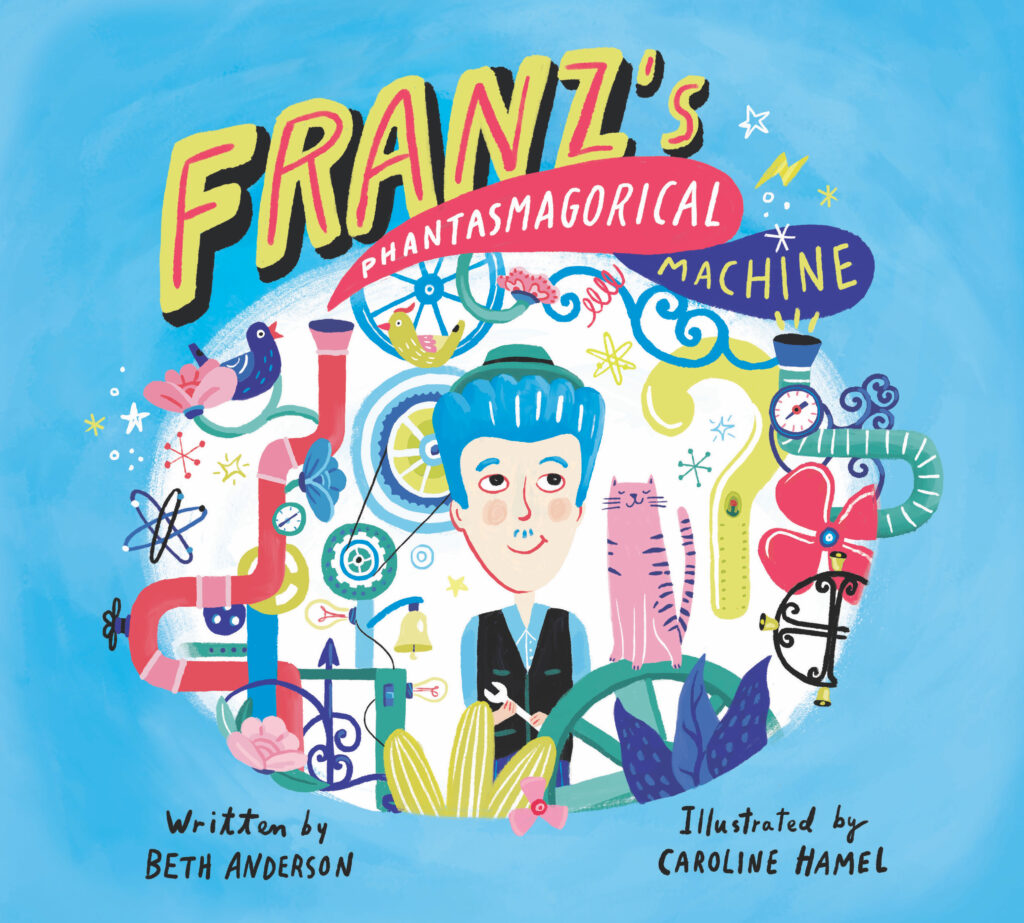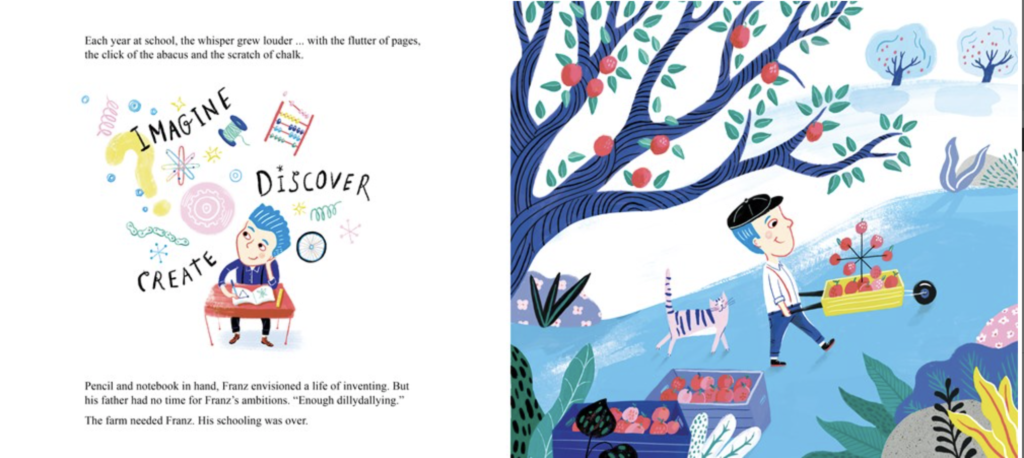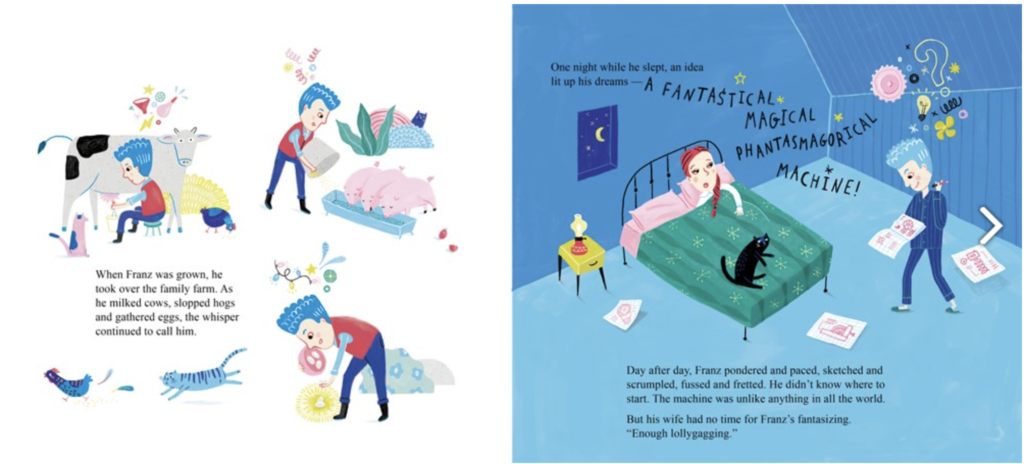Author Beth Anderson has a new book out in the world, and it’s a doozy!

Here’s the gist of the story, from the publisher:
“… offers an engaging look at the inspiring life of Franz Gsellmann, an inventor from rural Austria who, with no formal artistic or engineering training, built an elaborate, intricate machine called the Weltmaschine (World Machine). The well-told story extols the joy of curiosity and inventing for inventing’s sake, and explores the concept of mechanical-kinetic sculptures, in which art and science intersect….”
The story starts in Franz’s childhood on the family farm, where he first hears “A tiny whisper” calling him “to imagine, discover, create.” But his dreams are swiftly and continually stifled by his parents. After all, there’s work to do. No time for dillydallying. Franz can only imagine a more inventive sort of life.
We skip to Franz’s adulthood. Franz is finally his own boss, dreaming of a “fantastical magical phantasmagorical machine.” Still he tamps down that creative urge. But when he reads in a newspaper about a structure at the world’s fair in Brussels, nothing can hold him back. He travels to get a look at the thing and discovers how “ordinary shapes and lights could become something extraordinary.” Well, heck yes! Back home, he finally goes after his dream. Nobody else understands what he’s trying to do, but if there’s one thing Franz has learned it’s that he can no longer allow himself to be ruled by other people’s short-sightedness.
Anderson knows exactly how to sneak in details that don’t call attention to themselves, yet subtly convey a time period. Like this…
“Each year at school, the whisper grew louder … with the flutter of pages, the click of the abacus and the scratch of chalk.”
…and paint scenes guaranteed to seep into a reader’s psyche (without hitting them over the head), like this one in which the adult Franz spends every free minute in his workshop, tinkering with his ever-growing machine:
“‘What’s going on in there?’ asked the neighbors. They snickered at Franz’s lack of skills. But Franz listened only to his imagination.”
Poor Franz. Talk about peer pressure! As his machine grows ever larger and more complicated, so do the naysayers:
“‘What’s going on in there?’ Villagers clamored at the windows and barked insults. Franz said nothing. Though their taunts stung, he refused to give up.”
Caroline Hamel’s illustrations give Franz’s story the just-right amount of whimsy without losing the follow-your-heart vibe. I had to ask Beth about this inspirational (and beautifully structured) story.

JE: Hello, Beth! Thanks for agreeing to a chat. What I love about Franz is how he remained true to himself and his vision, despite the opinions of others (a story with built-in heart!). What a tremendous subject for a biography. How did you discover him?

BA: You know me…I’m always on the lookout for the obscure and intriguing! I saw the World Machine in a short article, read a little bit about Franz Gsellmann, and immediately had to know more. I dug in, and the story grabbed the child tinkerer in me. I was hooked! And as I wrote, revised, and submitted, I recognized that his process of building the machine reflected my own experience writing his story.
Besides the personal connections, I knew the urge to tinker and build, powered by curiosity and spurred on by pure joy, connects to every child. The items in the machine are fascinating and kid-friendly. In-motion, the machine is astonishing. Franz’s process was one of learning as he went, trial and error, experimentation. He struggled to push past criticism. Franz seemed so relatable, and I felt he was sort of a quirky “everyman.”
Franz followed the “calling” he felt inside. Despite his lack of mechanical and electrical skills, limited education, and meager resources, his imagination saw no bounds. He recycled and upcycled (so timely!) and found inspiration in the world around him. I admired his courage and perseverance. I applauded his creativity. I loved how his project tests our expectations and prompts us to think a bit differently.

JE: I’ll say! What element was toughest for you to get exactly right?
BA: I was drawn to the potential challenge that Franz and the World Machine present to a reader—of thinking about things differently and the question of value. I didn’t want to tell the reader what to think, I just wanted the reader to ponder a bit. While my goal is to avoid being didactic, I know sometimes I leave a little too much for the reader to infer. Kids are smart, but it’s a fine line between confusion and an invitation to ponder a question! As the writer, you become so familiar with all that’s going on that it’s hard to recognize “enough” vs. “too much.” The manuscript needed some clarity in a few spots that I had left too wide open.
Pacing was also a challenge, and partly because I was still so new at this kid lit writing endeavor when I started this story. Writing scenes with the growing machine and noises proved lots of fun. Franz had to tear down a wall to move the machine to a larger space and then had to build onto his workshop as the machine grew. Despite the thrill a cornucopia of onomatopoeia brings a word nerd like me, the ever larger machine and its noises had to be cut back to avoid bogging down.
JE: You’re never didactic, Beth. You’re a master of show; don’t tell. That’s one of the things I always appreciate about your books! What prompted the decision to write Franz’s story as fiction?
BA: With a few of the stories I’ve wanted to tell, there have been limited sources and information on the subject. (I define story, not as the series of events, but as the emotional arc that carries readers along on the journey and leaves them with a resonating idea to “take away.”) So, as I see it, that leaves you with several options:
1. Don’t write it at all. (But what if the story really offers something special? What if it’s a story that needs to be told?)
2. Stick to the facts and strict nonfiction and risk a less-than-engaging story. (Who wants to read that? Who would even publish that?)
3. Use the most verifiable information, imagine a bit if needed, and create an engaging, meaningful story. (Yes!)
Because…if we only tell the stories that have a complete historical record, we’re going to miss a lot of people and important stories. And…if we can’t make a story meaningful and engaging, what’s the point? Sometimes the most important truths of a story aren’t in the historical record or available in the research. Of course, it depends on who your subject is, and other factors like whether you did your due diligence—and I know some authors would disagree. For me, story is first and foremost. I prefer to tell a powerful story and be transparent about any small pieces that we can’t be certain about—as long as those pieces aren’t vital to the significance of the story.
JE: Totally agree. Let’s talk back matter. It’s all stellar, but the seek-and-find especially connected with me, since my grandkids are wild for those. What a clever way to help readers understand (and remember) the kind of ordinary items Franz used. Whose idea was this out-of-the-box addition?
BA: That was one of my requests. Because I couldn’t stop “seeking and finding” as I wrote!
Once you see the list of 1,960 items, you just can’t help yourself. The challenge of doing it fell to the editor, art director, and illustrator. Just seemed like the perfect piece of fun to add to the story.
JE: That number staggers the imagination. Tell us about your next release, Beth. And can you tell us what you’re working on now without giving too much away?
BA: CLOAKED IN COURAGE: UNCOVERING DEBORAH SAMPSON, PATRIOT SOLDIER releases Nov. 15, 2022. It’s another Calkins Creek title, with superb illustrations by Anne Lambelet. Sampson fought in the Continental Army for 17 months before anyone realized she was a woman. It’s an amazing story, but it’s fraught with potholes from misinformation that’s been perpetuated. Since it became a lesson in being a history detective, I shared a lot of that in the back matter.

I have a few works in progress—two are under contract but unannounced. Those are both stories involving amazing young women. As to what I’m writing…I’ve hit major barriers with research for a couple ideas, but am ready to focus on one, take the deep dive, and see if I can make what’s in my head happen on the page!
GIVEAWAY! GIVEAWAY! GIVEAWAY! For a chance to win your very own copy of FRANZ’S PHANTASMAGORICAL MACHINE, simply leave a comment below by Friday, June 10th. Beth will notify the winner shortly thereafter. Thanks for visiting PBB, loyal readers!

I’m excited to see this book and Cloaked in Courage too! How do you find such interesting historical figures?
Thanks, Mary! I’m always on the lookout, exploring newsfeeds and various articles that catch my attention. I end up seeking a needle in the haystack!
“I recognized that his process of building the machine reflected my own experience writing his story.” This is so lovely. Beth, congratulations! There is so much to be said for doing the things that matter for their own sake as opposed to only looking at their utility. I can’t wait to read Franz’ and Deborah’s stories. I love too, seek and ye shall find 🙂
Thanks, Vijaya! I find each story I tackle has something to teach me or reflects the writing journey in some way. Even the seek and find in this book!
Gotta love the obscure and intriguing! Both of these books look great! Thanks for sharing!
thanks for your interest, Jessica!
Hi Beth: I am a HUGE FAN of your books! I TRULY CAN’T WAIT to read this one, as well as “Cloaked in Courage.” The illustrations for both are AMAZING! I am emailing myself this post so I can continue to turn back to it for the guidance and INSPIRATION to remember that in order to “create an engaging, meaningful story,” THE STORY MUST ALWAYS COME FIRST! THANK YOU!!!
Oh my gosh, I’m so honored! Good luck with your writing!
Book looks awesome! Hope I win this for my twins!
Oooooh – double the curiosity and creative fun!
nice covers
I’m so excited to read more of Beth’s books. I have absolutely loved each one I’ve read so far.
Two lovely books!…I love the covers.